Clean looking sensor node
-
@nca78
What's the best way to remove the cover on this thing? Do I just go for it with a pry tool, or is there a special trick to it?I'm hopeful it will fit a CR2477 tabbed battery, but it would likely be a very close fit if it does. In case it doesn't, have you come across any options that are a bit thicker?
-
So, here's an example of such a $1 solar garden light:

Don't buy them for outdoor use, although that's what they're sold for. They'll rapidly corrode in wet weather and then cease to function. However, that shouldn't be a problem indoors.
Demounting the solar puck, it looks like this:
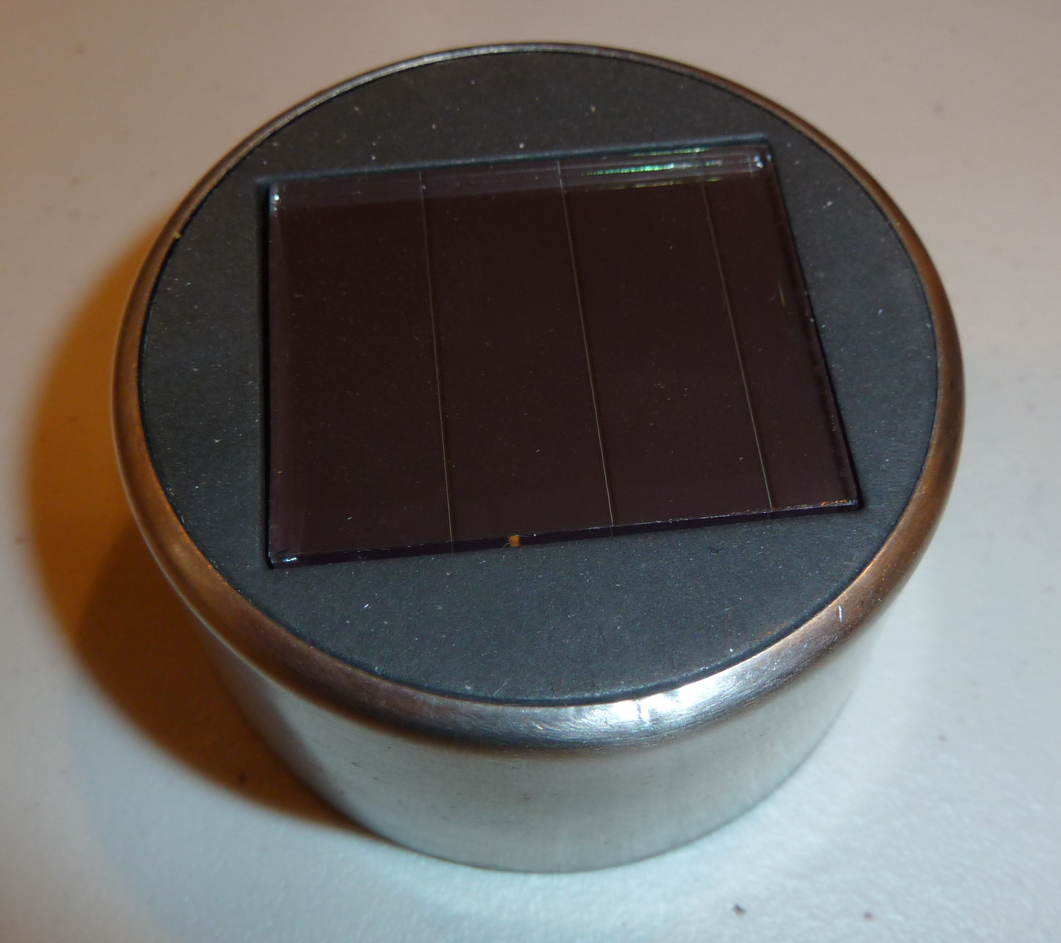
Here's the flip side with the guts removed:
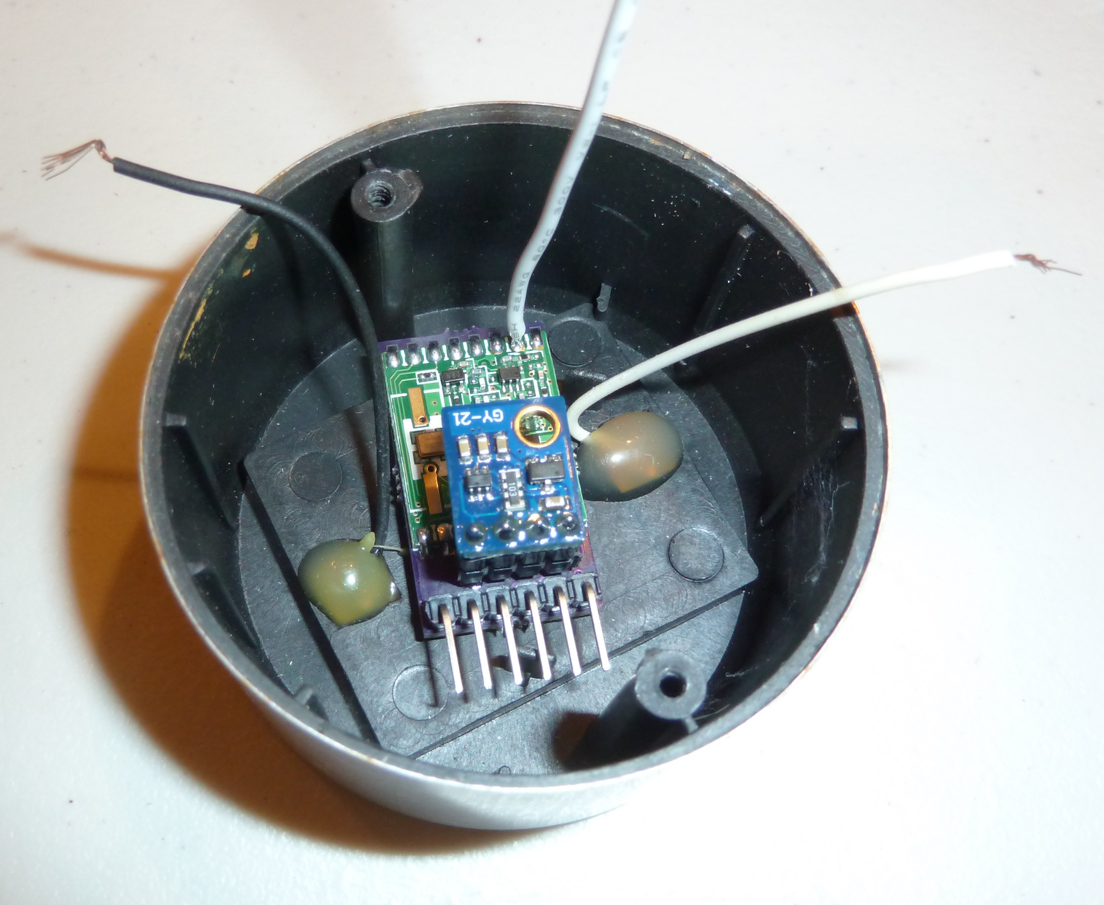
Inside I put one of my RFM69HW temp-RH nodes. As you can hopefully see, there is room to spare.
These close-up photos probably make the puck look larger than it is. It is just 2-1/4" in diameter and 1-1/8" tall.
What do you think? Would it have good WAF? This one is a bit crufty because it was outside for about a year, and then I plucked it for these photos. When brand new they look more clean and polished, and so perhaps if kept indoors they would stay that way.
One possible concern with this particular example is that it has a metal band around it. That's not so ideal for an RF node, but it may not matter, as I tested the PCB node (just by itself, without the solar puck) within a closed refrigerator and still got adequate signal from it.
@NeverDie said:
One possible concern with this particular example is that it has a metal band around it. That's not so ideal for an RF node, but it may not matter, as I tested the PCB node (just by itself, without the solar puck) within a closed refrigerator and still got adequate signal from it.
I tried running one of my nodes inside the solar puck that has the metal band (above). It's maybe a few dB worse, but the link budget is large enough that it just doesn't really matter. So, I think it remains a viable option as an enclosure for thicker nodes that don't easily fit inside the OP's thinner recharger puck.
-
@nca78
What's the best way to remove the cover on this thing? Do I just go for it with a pry tool, or is there a special trick to it?I'm hopeful it will fit a CR2477 tabbed battery, but it would likely be a very close fit if it does. In case it doesn't, have you come across any options that are a bit thicker?
@NeverDie said:
@nca78
What's the best way to remove the cover on this thing? Do I just go for it with a pry tool, or is there a special trick to it?I'm hopeful it will fit a CR2477 tabbed battery, but it would likely be a very close fit if it does. In case it doesn't, have you come across any options that are a bit thicker?
Sorry no magic solution to open :)
For the cell it should fit a 2477 but you need a thin PCB + thin holder.
Box is 10.6mm high minus 1.2mm thickness for the cover and 0.8mm PCB it leaves you with 8.6mm. 2477 is 7.7mm so you have 1mm left, not much but I think just enough if you use basic holder that's just made of a folded metal sheet.
But for such a basic sensor you would not need such a huge cell, CR2032 should last a very long time already, and 2450 could match your need of extra long lifetime and at the same time easily fit in the box. If your sketch is programmed correctly by the time a 2450 is dead the sensor will probably have become completely off because of aging ;) -
I received the Q8 wireless charging pad (above):
http://www.ebay.com/itm/Q8-QI-Wireless-Charging-Pad-2-USB-Port-Splitter-HUB-Charger-Pad-For-Phone-F5/301913729117?_trksid=p2047675.c100623.m-1&_trkparms=aid%3D222007%26algo%3DSIC.MBE%26ao%3D1%26asc%3D39345%26meid%3Decb1959e8f164eb5ad0a17aeaa297f59%26pid%3D100623%26rk%3D3%26rkt%3D6%26sd%3D252485416371However, it is even thinner than the OP's vented puck, and it's about double the square inches of foot print. So I don't see any real advantage to them.
-
For a thicker case, Amazon Dot looks like it might be very nice:

A bit pricey though! -
I received the Q8 wireless charging pad (above):
http://www.ebay.com/itm/Q8-QI-Wireless-Charging-Pad-2-USB-Port-Splitter-HUB-Charger-Pad-For-Phone-F5/301913729117?_trksid=p2047675.c100623.m-1&_trkparms=aid%3D222007%26algo%3DSIC.MBE%26ao%3D1%26asc%3D39345%26meid%3Decb1959e8f164eb5ad0a17aeaa297f59%26pid%3D100623%26rk%3D3%26rkt%3D6%26sd%3D252485416371However, it is even thinner than the OP's vented puck, and it's about double the square inches of foot print. So I don't see any real advantage to them.
@NeverDie said:
I received the Q8 wireless charging pad (above):
http://www.ebay.com/itm/Q8-QI-Wireless-Charging-Pad-2-USB-Port-Splitter-HUB-Charger-Pad-For-Phone-F5/301913729117?_trksid=p2047675.c100623.m-1&_trkparms=aid%3D222007%26algo%3DSIC.MBE%26ao%3D1%26asc%3D39345%26meid%3Decb1959e8f164eb5ad0a17aeaa297f59%26pid%3D100623%26rk%3D3%26rkt%3D6%26sd%3D252485416371However, it is even thinner than the OP's vented puck, and it's about double the square inches of foot print. So I don't see any real advantage to them.
I have ordered one also (In fact two as aliexpress payment messed up and asked me to process payment again, but few days after I realized the "failed" payment was in fact processed and sellers were sending everything twice...).
I'm planning to use one as gateway box with wemos d1 mini and smd pa/lna NRF24 side by side. Any chance it will fit this type of ESP board inside or it's too thin and I should go for ESP12 module instead ? -
@NeverDie said:
I received the Q8 wireless charging pad (above):
http://www.ebay.com/itm/Q8-QI-Wireless-Charging-Pad-2-USB-Port-Splitter-HUB-Charger-Pad-For-Phone-F5/301913729117?_trksid=p2047675.c100623.m-1&_trkparms=aid%3D222007%26algo%3DSIC.MBE%26ao%3D1%26asc%3D39345%26meid%3Decb1959e8f164eb5ad0a17aeaa297f59%26pid%3D100623%26rk%3D3%26rkt%3D6%26sd%3D252485416371However, it is even thinner than the OP's vented puck, and it's about double the square inches of foot print. So I don't see any real advantage to them.
I have ordered one also (In fact two as aliexpress payment messed up and asked me to process payment again, but few days after I realized the "failed" payment was in fact processed and sellers were sending everything twice...).
I'm planning to use one as gateway box with wemos d1 mini and smd pa/lna NRF24 side by side. Any chance it will fit this type of ESP board inside or it's too thin and I should go for ESP12 module instead ?@Nca78 said:
@NeverDie said:
I received the Q8 wireless charging pad (above):
http://www.ebay.com/itm/Q8-QI-Wireless-Charging-Pad-2-USB-Port-Splitter-HUB-Charger-Pad-For-Phone-F5/301913729117?_trksid=p2047675.c100623.m-1&_trkparms=aid%3D222007%26algo%3DSIC.MBE%26ao%3D1%26asc%3D39345%26meid%3Decb1959e8f164eb5ad0a17aeaa297f59%26pid%3D100623%26rk%3D3%26rkt%3D6%26sd%3D252485416371However, it is even thinner than the OP's vented puck, and it's about double the square inches of foot print. So I don't see any real advantage to them.
I have ordered one also (In fact two as aliexpress payment messed up and asked me to process payment again, but few days after I realized the "failed" payment was in fact processed and sellers were sending everything twice...).
I'm planning to use one as gateway box with wemos d1 mini and smd pa/lna NRF24 side by side. Any chance it will fit this type of ESP board inside or it's too thin and I should go for ESP12 module instead ?I just now measured the D1Mini, and it's about 6.7mm thick. If you removed the USB connector, it would be thinner.
I haven't opened the QB wireless pad, so I don't know how much depth is available. However, the case itself is 8.5mm thick. In comparison, I measure the case thickness of your OP puck as 11.7mm.
-
@Nca78 said:
@NeverDie said:
I received the Q8 wireless charging pad (above):
http://www.ebay.com/itm/Q8-QI-Wireless-Charging-Pad-2-USB-Port-Splitter-HUB-Charger-Pad-For-Phone-F5/301913729117?_trksid=p2047675.c100623.m-1&_trkparms=aid%3D222007%26algo%3DSIC.MBE%26ao%3D1%26asc%3D39345%26meid%3Decb1959e8f164eb5ad0a17aeaa297f59%26pid%3D100623%26rk%3D3%26rkt%3D6%26sd%3D252485416371However, it is even thinner than the OP's vented puck, and it's about double the square inches of foot print. So I don't see any real advantage to them.
I have ordered one also (In fact two as aliexpress payment messed up and asked me to process payment again, but few days after I realized the "failed" payment was in fact processed and sellers were sending everything twice...).
I'm planning to use one as gateway box with wemos d1 mini and smd pa/lna NRF24 side by side. Any chance it will fit this type of ESP board inside or it's too thin and I should go for ESP12 module instead ?I just now measured the D1Mini, and it's about 6.7mm thick. If you removed the USB connector, it would be thinner.
I haven't opened the QB wireless pad, so I don't know how much depth is available. However, the case itself is 8.5mm thick. In comparison, I measure the case thickness of your OP puck as 11.7mm.
@NeverDie said:
I haven't opened the QB wireless pad, so I don't know how much depth is available. However, the case itself is 8.5mm thick. In comparison, I measure the case thickness of your OP puck as 11.7mm.
Thank you. Sounds like it won't fit :(
For Amazon Dot yes it looks great, but 50$ is a bit too expensive for a case :D -
I notice that Kalia made his own uniquely shaped enclosure that he 3D printed himself:

(for more detail see his posts under: https://forum.mysensors.org/topic/1566/mysensors-sensebender-micro-3dp-case/18)I'm not yet savvy about 3D printers, but from what I've been reading lately the line artifacts in the plastic may vary in how prominent they are depending on the quality of the software slicer that's used to produce the g-code that's sent to the 3D printer. Still, I'm not sure to what extent it's avoidable or just a reality of 3D prints. Would such line artifacts always be visible, regardless of which printer or software produced it?
In any event, I like the way Kali molded the battery holder into the case itself. Very clever!
-
I notice that Kalia made his own uniquely shaped enclosure that he 3D printed himself:

(for more detail see his posts under: https://forum.mysensors.org/topic/1566/mysensors-sensebender-micro-3dp-case/18)I'm not yet savvy about 3D printers, but from what I've been reading lately the line artifacts in the plastic may vary in how prominent they are depending on the quality of the software slicer that's used to produce the g-code that's sent to the 3D printer. Still, I'm not sure to what extent it's avoidable or just a reality of 3D prints. Would such line artifacts always be visible, regardless of which printer or software produced it?
In any event, I like the way Kali molded the battery holder into the case itself. Very clever!
-
@NeverDie the lines will be more or less visible depending on layer height (which varies by 3d printer model) but can easily be made totally smooth. See this video
@mfalkvidd said:
@NeverDie the lines will be more or less visible depending on layer height (which varies by 3d printer model) but can easily be made totally smooth. See this video
Funny that in the video the demonstrator uses a polypropylene chamber, as I'm pretty sure acetone will strongly react with it. Aside from that, though, it was a good video. Thanks for posting it!
He seems to imply this acetone vapor chamber approach only works on ABS printed models. Is that correct?
Also, what must the 3D printer's layer height be for the lines to no longer be visible (without resorting to acetone vapors)?
-
Looks as though my small TH mote will have no problem fitting inside the OP's enclosure:
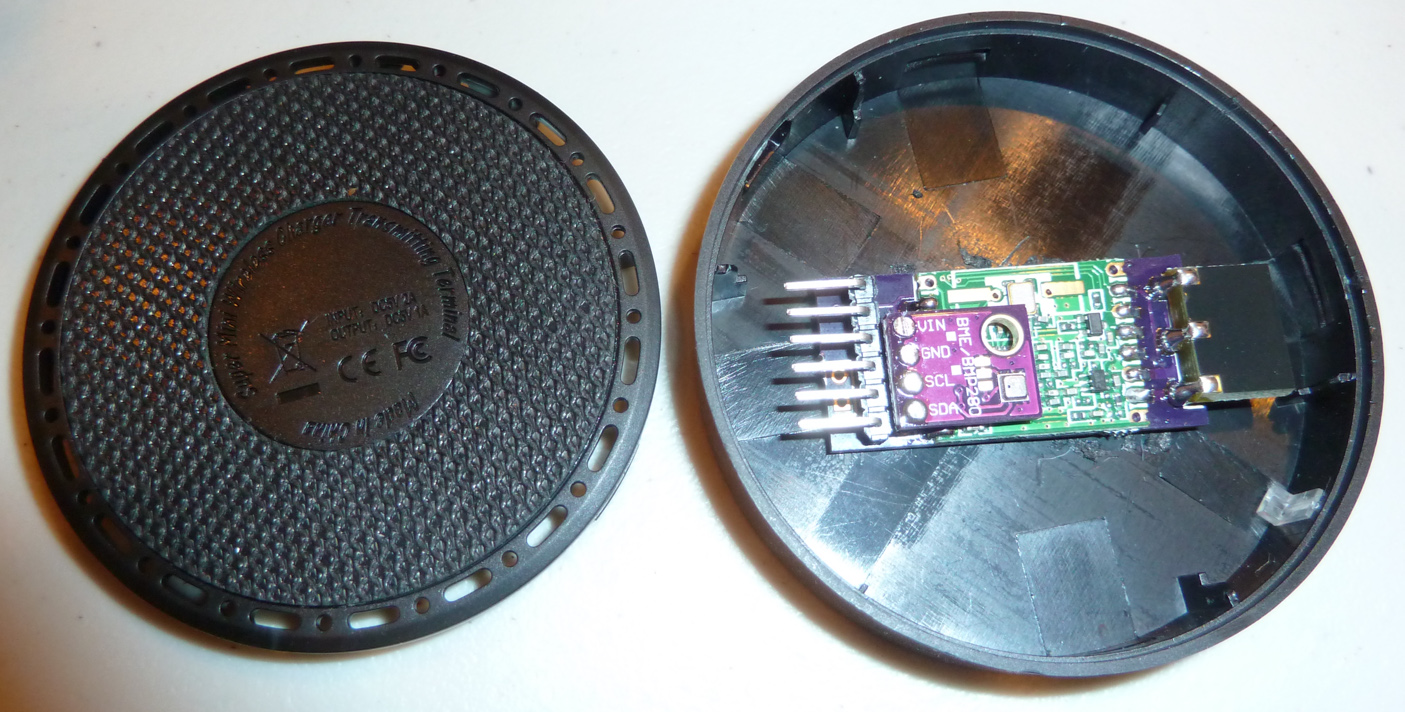
I can also configure my medium TH mote to also fit. The enclosure is too thin to accomodate AAA batteries, but I should be receiving the button cell batteries from China very soon.
-
Looks as though my small TH mote will have no problem fitting inside the OP's enclosure:

I can also configure my medium TH mote to also fit. The enclosure is too thin to accomodate AAA batteries, but I should be receiving the button cell batteries from China very soon.
@NeverDie said:
Looks as though my small TH mote will have no problem fitting inside the OP's enclosure:

I can also configure my medium TH mote to also fit. The enclosure is too thin to accomodate AAA batteries, but I should be receiving the button cell batteries from China very soon.
Don't forget a capacitor parrallel to the button cell battery if you want it to last more than a few days ;)
-
@NeverDie said:
Looks as though my small TH mote will have no problem fitting inside the OP's enclosure:

I can also configure my medium TH mote to also fit. The enclosure is too thin to accomodate AAA batteries, but I should be receiving the button cell batteries from China very soon.
Don't forget a capacitor parrallel to the button cell battery if you want it to last more than a few days ;)
@Nca78 said:
Don't forget a capacitor parrallel to the button cell battery if you want it to last more than a few days ;)
That's good input, as I haven't yet tried running it on a button cell. Is a button cell alone just not able to keep up with the Tx load? I had wanted to avoid button cells altogether, but even an AAA battery has too wide a diameter to fit in this enclosure.
-
It might be worthwhile to make a board specifically for this enclosure. It would necessarily have to have a somewhat similar size as the board that was in it, so that it could mount an LED near the LED window, and a micro USB at the USB window, all while fitting the groves of the enclosure.
BTW, how did you get that sticky black foam tape out of it? I tried scrapping it off, but I didn't manage to remove all of it.
-
@Nca78 said:
Don't forget a capacitor parrallel to the button cell battery if you want it to last more than a few days ;)
That's good input, as I haven't yet tried running it on a button cell. Is a button cell alone just not able to keep up with the Tx load? I had wanted to avoid button cells altogether, but even an AAA battery has too wide a diameter to fit in this enclosure.
@NeverDie said:
That's good input, as I haven't yet tried running it on a button cell. Is a button cell alone just not able to keep up with the Tx load? I had wanted to avoid button cells altogether, but even an AAA battery has too wide a diameter to fit in this enclosure.
No it can't keep up with it without a serious voltage drop, especially at startup and with RFM radio. A 100µF ceramic capacitor (and sleep between successive tx in your code) should be enough from what I read from scalz who made a few boards with button cell + RFM.
I just uploaded version 0.2 of my dedicated board to Seeed, it should be just the right size this time :) Led is in front of the led window but on USB side I don't have anything, it's just a vent.
For the black tape I don't remember having so much pain to remove it, maybe it's different between enclosures, I will tell you when I receive the next one. -
@NeverDie said:
That's good input, as I haven't yet tried running it on a button cell. Is a button cell alone just not able to keep up with the Tx load? I had wanted to avoid button cells altogether, but even an AAA battery has too wide a diameter to fit in this enclosure.
No it can't keep up with it without a serious voltage drop, especially at startup and with RFM radio. A 100µF ceramic capacitor (and sleep between successive tx in your code) should be enough from what I read from scalz who made a few boards with button cell + RFM.
I just uploaded version 0.2 of my dedicated board to Seeed, it should be just the right size this time :) Led is in front of the led window but on USB side I don't have anything, it's just a vent.
For the black tape I don't remember having so much pain to remove it, maybe it's different between enclosures, I will tell you when I receive the next one. -
On my medium node, I found that if I used right-angle FTDI header pins and if I splayed the antenna and the Temp-humidity-pressure sensor out horizontally, then the overall thickness was low enough that I could fit it inside the OP's enclosure.
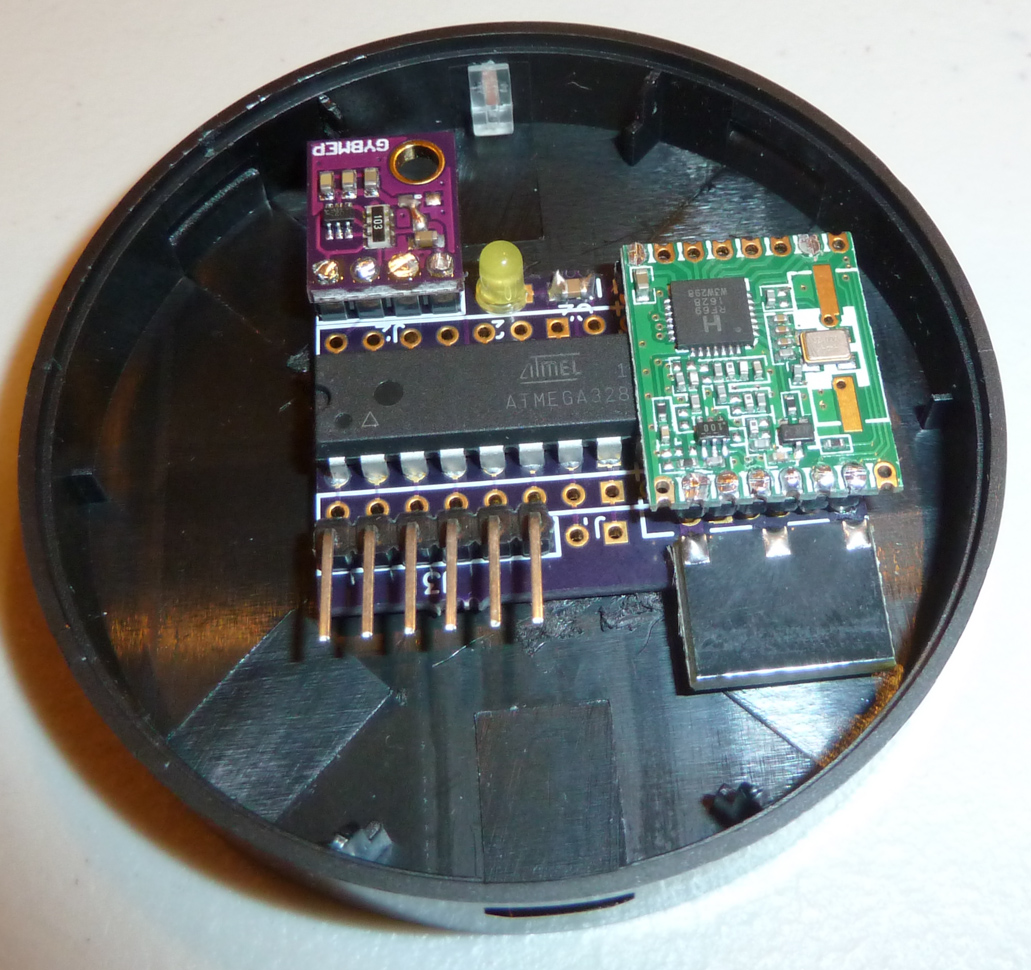
Also, I think that if, rather than clipping the LED's legs after soldering it close to the board, I instead left the LED legs long, then I could bend it over and have it pointed at the LED window on the OP's enclosure, to maximize its visibility outside the closed enclosure. So, on a future version, I'll try that. -
After a long-wait, I received my so called "tabbed" CR2477 batteries today from China via AliExpress. According to the seller, they would look like this:
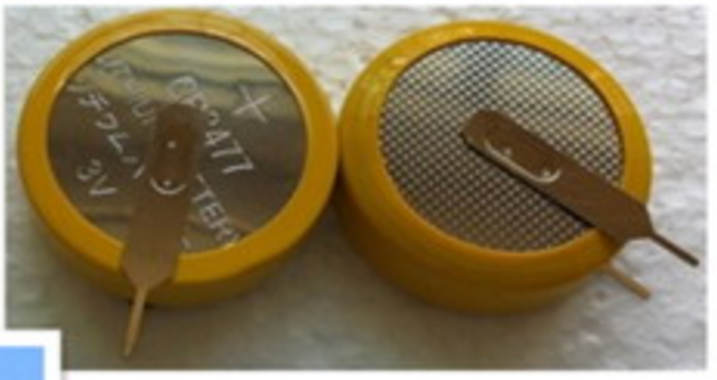
and so that is what I was expecting. Instead, what the seller sent me was:

which obviously has no tabs. :cry:Anyhow, the second photo shows the depth of the battery in relation to the OP's case. It looks to me as though with tabs it likely would have been too thick for the cover to snap back on the OP case.
-
@NeverDie
:open_mouth: not cool
I hope your 2477 will work well ;)
my little xp about coincells showed me that i can't trust ali coincells.. well i tried only few orders, but those wasted my time searching for bugs whereas batt were discharged and didn't check this in first place as i was using fresh ali coincells. I was thinking it couldn't be that! Then i checked their voltage in case...and was surprised!
Changing for good and strong coincell was day&night.if it can help you to not run in dumb issue, for future :)
